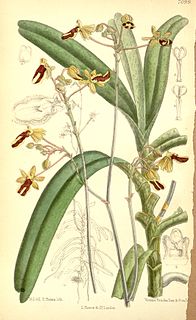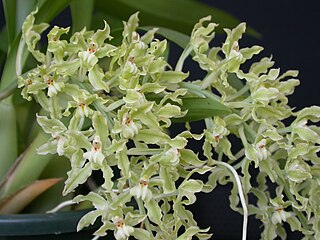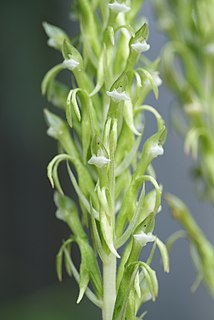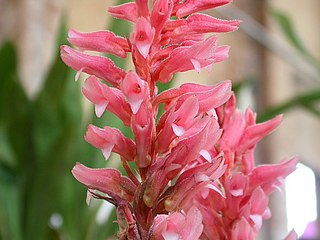
The Orchidaceae are a diverse and widespread family of flowering plants, with blooms that are often colourful and fragrant, commonly known as the orchid family.

Cypripedioideae is a subfamily of orchids commonly known as lady's slipper orchids, lady slipper orchids or slipper orchids. Cypripedioideae includes the genera Cypripedium, Mexipedium, Paphiopedilum, Phragmipedium and Selenipedium. They are characterised by the slipper-shaped pouches of the flowers – the pouch traps insects so they are forced to climb up past the staminode, behind which they collect or deposit pollinia, thus fertilizing the flower. There are approximately 165 species in the subfamily.
The taxonomy of the Orchidaceae has evolved slowly during the last 250 years, starting with Carl Linnaeus who in 1753 recognized eight genera. De Jussieu recognized the Orchidaceae as a separate family in his Genera Plantarum in 1789. Olof Swartz recognized 25 genera in 1800. Louis Claude Richard provided us in 1817 with the descriptive terminology of the orchids.. The next step was taken in 1830-1840 by John Lindley, who recognized four subfamilies. He is generally recognized as the father of orchid taxonomy. The next important step was taken by George Bentham with a new classification, recognizing subtribes for the first time. This classification was first presented in a paper that Bentham read to the Royal Society in 1881. Then it was published in 1883 in the final volume of Genera Plantarum. The next great contributors were Pfitzer (1887), Schlechter (1926), Mansfeld (1937), Dressler and Dodson (1960), Garay, Vermeulen (1966), again Dressler (1981). and Burns-Balogh and Funk (1986). Dressler's 1993 book had considerable influence on later work.
Caluera is a genus of flowering plants in the orchid family, Orchidaceae. It contains three species, all native to South America:

Cottonia is a monotypic genus of flowering plants from the orchid family, Orchidaceae: the only known species is Cottonia peduncularis. It is native to India and Sri Lanka. The genus was erected by Robert Wight and named after Major F. Cotton, an amateur botanist who served in the Madras Engineer Group and collected the species from Tellichery.
Degranvillea is a genus of flowering plants from the orchid family, Orchidaceae. At the present time, there is only one known species, Degranvillea dermaptera, endemic to French Guiana

Gomesa is a genus of flowering plants from the orchid family, Orchidaceae. It contains about 80–100 species, all native to South America.
Gonatostylis is a genus of flowering plants from the orchid family, Orchidaceae. It contains only two species, both endemic to New Caledonia.

Hagsatera is a genus of flowering plants from the orchid family, Orchidaceae. There are two known species, native to Mexico and Guatemala:
Hederorkis is a genus of flowering plants from the orchid family, Orchidaceae. It contains two known species, both native to islands in the Indian Ocean.

Phalaenopsis is a genus of flowering plants from the orchid family, Orchidaceae. Phalaenopsis hygrochila, is native to Assam, Yunnan, Bhutan, Myanmar, Laos, Thailand and Vietnam.

Telipogon is a genus of flowering plants from the orchid family, Orchidaceae. It is a large genus with dozens of species, native to South America, Central America, Hispaniola and southern Mexico.

Monophyllorchis is a monotypic genus of flowering plants from the orchid family, Orchidaceae. The sole species is Monophyllorchis microstyloides, native to Costa Rica, Nicaragua, Colombia and Ecuador.

Neotinea is a genus of flowering plants from the orchid family, Orchidaceae. It is native to much of Europe, the Mediterranean region, and the islands of the eastern Atlantic, from the Canaries, Madeira and Ireland east to Iran and Western Siberia.
Galeottiella is a genus of flowering plants from the orchid family, Orchidaceae. Traditionally it had been included in subtribe Spiranthinae, but following molecular phylogenetic and morphological studies it is now placed in a subtribe on its own, Galeottiellinae.

Pelexia is a genus of flowering plants from the orchid family, Orchidaceae. It has about 60-70 accepted species, native to Latin America, the West Indies and Florida.
Physogyne is a genus of flowering plants from the orchid family, Orchidaceae. It contains three known species, all endemic to Mexico.
Platyrhiza is a monotypic genus of flowering plants from the orchid family, Orchidaceae. The sole species is Platyrhiza quadricolor, endemic to Brazil.

Sacoila is a genus of flowering plants from the orchid family, Orchidaceae, native to the Western Hemisphere. It occurs in Mexico, Central America, South America, the West Indies and Florida.

Dendrobieae is a tribe in the subfamily Epidendroideae, in the family Orchidaceae.











